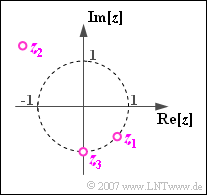Difference between revisions of "Aufgaben:Exercise 1.3: Calculating with Complex Numbers"
| Line 66: | Line 66: | ||
===Musterlösung=== | ===Musterlösung=== | ||
{{ML-Kopf}} | {{ML-Kopf}} | ||
| − | '''1.''' Entsprechend den Angaben gilt mit dem | + | '''1.''' Entsprechend den Angaben gilt mit dem [[Signaldarstellung/Zum_Rechnen_mit_komplexen_Zahlen#Darstellung_nach_Betrag_und_PhaseSatz von Euler]]: |
<math>2 \cdot z_1 + z_2 = 2 \cdot \cos(45^{ \circ}) - 2{\rm j}\cdot \sin(45^{ \circ})- 2 \cdot \cos(45^{ \circ}) + 2{\rm j} \cdot\sin(45^{ \circ}) = 0.</math> | <math>2 \cdot z_1 + z_2 = 2 \cdot \cos(45^{ \circ}) - 2{\rm j}\cdot \sin(45^{ \circ})- 2 \cdot \cos(45^{ \circ}) + 2{\rm j} \cdot\sin(45^{ \circ}) = 0.</math> | ||
| Line 91: | Line 91: | ||
<math>z_3^2 = (-{\rm j})^2 = -1.</math> | <math>z_3^2 = (-{\rm j})^2 = -1.</math> | ||
| − | Somit ist <math>x_4</math> | + | Somit ist <math>x_4 = –1</math> und <math>y_4 = –4.</math> |
Revision as of 13:42, 13 January 2017
Nebenstehende Grafik zeigt einige Punkte in der komplexen Ebene, nämlich
$$z_1 = {\rm e}^{-{\rm j} 45^{ \circ}}, $$ $$z_2 = 2 \cdot{\rm e}^{{\rm j} 135^{ \circ}},$$ $$z_3 = -{\rm j} .$$
Im Verlauf dieser Aufgabe werden noch folgende komplexe Größen betrachtet: $$z_4 = z_2^2 + z_3^2,$$ $$z_5 = 1/z_2,$$ $$z_6 = \sqrt{z_3},$$ $$z_7 = {\rm e}^{z_2},$$ $$z_8 = {\rm e}^{z_2} + {\rm e}^{z_2^{\star}}.$$
Hinweise:
- Die Aufgabe gehört zum Kapitel Zum_Rechnen_mit_komplexen_Zahlen.
- Die Thematik wird auch im Lernvideo Rechnen mit komplexen Zahlen behandelt.
- Sollte die Eingabe des Zahlenwertes „0” erforderlich sein, so geben Sie bitte „0.” ein.
Fragebogen
Musterlösung
\(2 \cdot z_1 + z_2 = 2 \cdot \cos(45^{ \circ}) - 2{\rm j}\cdot \sin(45^{ \circ})- 2 \cdot \cos(45^{ \circ}) + 2{\rm j} \cdot\sin(45^{ \circ}) = 0.\)
Der zweite Vorschlag ist ebenfalls richtig, da
\(z_1^{\star} \cdot z_2 = 1 \cdot{\rm e}^{{\rm j} 45^{ \circ}} \cdot 2 \cdot{\rm e}^{{\rm j} 135^{ \circ}} = 2 \cdot{\rm e}^{{\rm j} 180^{ \circ}}= -2.\)
Dagegen ist der dritte Vorschlag falsch. Die Division von \(z_1\) und \(z_2\) liefert:
\(\frac{z_1}{z_2} = \frac{{\rm e}^{-{\rm j} 45^{ \circ}}}{2 \cdot{\rm e}^{{\rm j} 135^{ \circ}}} = 0.5 \cdot{\rm e}^{-{\rm j} 180^{ \circ}}= -0.5.\)
Die Multiplikation mit \(z_3 = -{\rm j} \) führt zum Ergebnis j/2, also zu einer rein imaginären Größe. Richtig sind also die Lösungsvorschläge 1 und 2.
2. Das Quadrat von \(z_2\) hat den Betrag \(|z_2|^{2}\) und die Phase \(2 \cdot \phi_2\):
\(z_2^2 = 2^2 \cdot{\rm e}^{{\rm j} 270^{ \circ}}= 4 \cdot {\rm e}^{-{\rm j} 90^{ \circ}}=-4 \cdot {\rm j}.\)
Entsprechend gilt für das Quadrat von \(z_3\):
\(z_3^2 = (-{\rm j})^2 = -1.\) Somit ist \(x_4 = –1\) und \(y_4 = –4.\)
3. Durch Anwendung der Divisionsregel erhält man:
\(z_5 = \frac{1}{z_2} = \frac{1}{2 \cdot e^{j135^{\circ}}} = 0.5 \cdot e^{-j135^{\circ}} = 0.5 \cdot (cos(-135^{\circ}) + j \cdot sin(-135^{\circ}))\) \(\Rightarrow x_5 = y_5 = - \frac{\sqrt{2}}{4}= -0.354\)
4. Die angegeben Beziehung für \(z_6\) kann wie folgt umgeformt werden:
\(z_6^2 = z_3 = e^{-90^{\circ}}\)
Man erkennt, dass es zwei Möglichkeiten für \(z_6\) gibt, die diese Gleichung erfüllen:
\(z_6(1.Loesung) = \frac{z_2}{2}= 1 \cdot e^{j135^{\circ}} \Rightarrow \phi_6 = 135^{\circ}\)
\(z_6(2.Loesung) = z_1= 1 \cdot e^{-j45^{\circ}} \Rightarrow \phi_6 = -45^{\circ}\)
5. Die komplexe Größe \(z_2\) lautet in Realteil/imaginärteildarstellung:
\(z_2 = x_2 + j \cdot y_2 = -\sqrt{2} + j \cdot \sqrt{2}\)
Damit ergibt sich für die komplexe Exponentialfunktion\[z_7 = e^{-\sqrt{2}+j \cdot \sqrt{2}} = e^{-\sqrt{2}} \cdot (cos(\sqrt{2} + j \cdot sin(\sqrt{2})\]
Mit
\(e^{-\sqrt{2}} = 0.243, \quad cos(\sqrt{2}) = 0.156, \quad sin(\sqrt{2}) = 0.988\)
erhält man somit:
\(z_7 = 0.243 \cdot (0.156 + j \cdot 0.988) = 0.038 + j \cdot 0.24\)
6. Ausgehend vom Ergebnis 4. erhält man für \(z_8\):
\(z_8 = e^{-\sqrt{2}} \cdot (cos(\sqrt{2}) + j \cdot sin(\sqrt{2}) + cos(\sqrt{2}) - j \cdot (\sqrt{2}))\)
\(2 \cdot e^{-\sqrt{2}} \cdot cos(\sqrt{2}) = 2 \cdot x_7\)
\(\Rightarrow x_8 = 0.076, \quad y_8 =0\)
